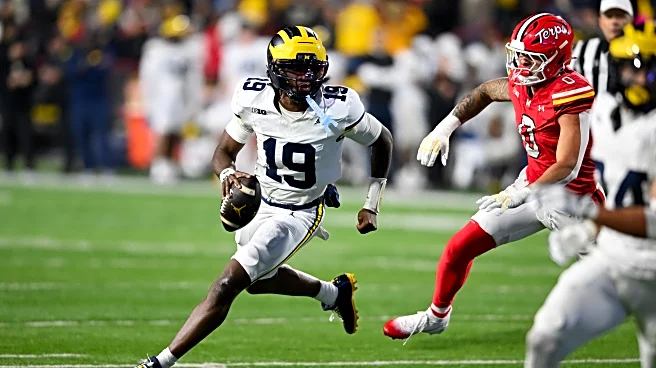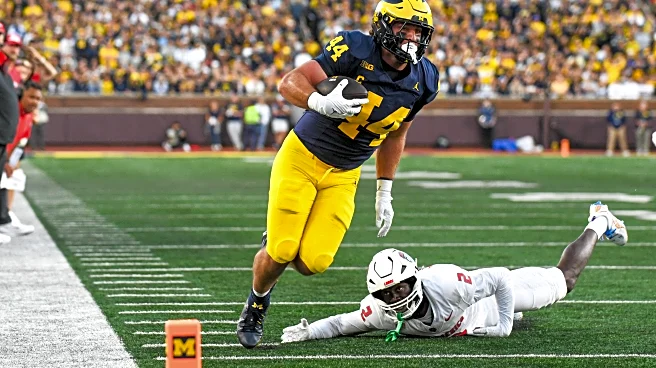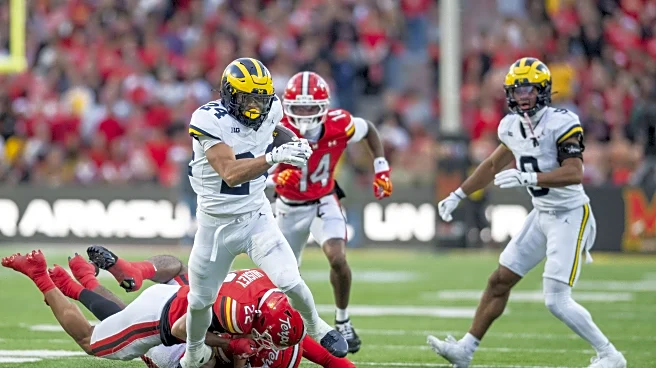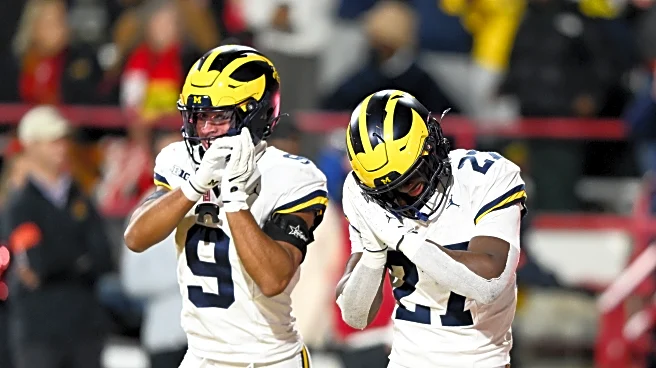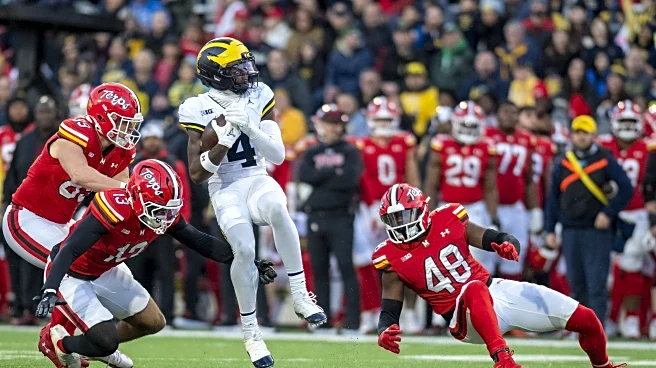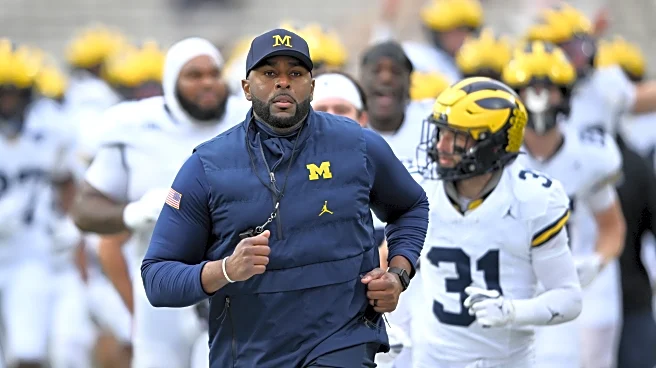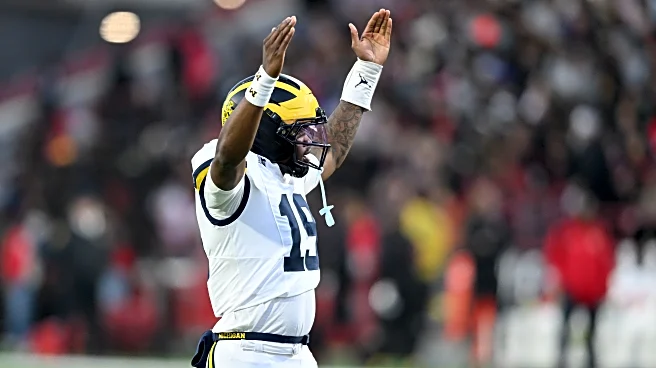No Justice Haynes, no Jordan Marshall, no problem. Behind the third-string running back Bryson Kuzdzal’s three rushing touchdowns, the Michigan Wolverines improved to 9-2 on the year following their best
overall performance of the season, defeating Maryland, 45-20. The story of the game was Kuzdzal for obvious reasons, but another “three” tells the story of why Michigan was so successful offensively.
The Wolverines were brilliant on third downs. Michigan was 12-for-14 on the penultimate down and never punted. Mind you, this was an offense that ranked No. 64 nationally in third down offense in September and No. 72 in October. But after Saturday’s masterclass, Michigan is the best third-down offense in all of college football during the month of November.
How has Michigan risen from mediocrity to the top of the mountain so fast? More consistently winning the first two downs has helped, but the growth and confidence of Bryce Underwood have been the bigger story. A week after his most up-and-down outing as a passer, he responded with growth and poise and delivered repeatedly to keep Michigan’s offense on the field.
Here are three examples of Underwood maturation and improvisation on third down that defined Michigan’s best performance of the season. Let’s check the tape!
3rd and 8 – 12-Personnel Double Slants + X-Fade
On Michigan’s first possession of the game, the Wolverines already needed a response. Trailing 7-0, it marked only the fourth time all season Michigan had not scored first. Clearly not a team built to play from behind, Michigan had posted a 1-2 record in the prior three games when playing catch-up.
However, after a failed ballsy onside kick attempt, the Wolverines marched down the field and easily converted the first third down of the game with a two-yard run from Kuzdzal. Facing another critical junction at the 12-yard line, Michigan needed to lean on Underwood.
Facing a 3rd-and-8 from the left hash, the Wolverines came out with two tight ends and twins to either side. At the top of the formation, Zack Marshall was the split end with wide receiver Donaven McCulley in the slot. To the bottom, Marlin Klein was in the slot and wide receiver Andrew Marsh split out.
The Wolverines want to sell their familiar staple of four slants. Both Marshall and Marsh are going to fake inside before running fades, while McCulley and Klein (the primaries) run slants over the middle. But before the ball is snapped, Michigan’s offense takes a page out of their opponents’ recent plan of attack with a hard count.
Maryland jumps offsides and center Greg Crippen smartly snaps the ball to give the Wolverines a free play. This is like swinging for the fences with a 3-0 count. Knowing this, Underwood immediately looks for the home run.

He takes a quick drop, sets his feet and flicks a perfect pass right into the bread basket of Marsh, who makes a beautiful contested catch in the end zone. Underwood could have looked where the play was designed — McCulley or Klein — but knowing he had house money, he took a shot and tied the game at seven apiece.
3rd and 4 – 12-Personnel Levels Concept Checkdown
On Michigan’s second drive of the game, the Wolverines had a chance to take the lead, but faced some adversity early in the possession. Following an incompletion that was nearly pick-sixed and a false start on center Greg Crippen for taking a deep breath, Michigan faced a 2nd-and-15 from its own 17. After a slick hitch route from Marsh to take advantage of a zone defender, the Wolverines were set up with a more manageable 3rd-and-4.
The Wolverines again turn to 12-personnel for the conversion. If you’re wondering why Michigan is operating increasingly more out of two tight end sets, it’s due to the ability to run or pass effectively from this personnel grouping. Michigan has an abundance of capable tight ends and this formation prevents defenses from overloading to stop the pass or the run, and instead forces them into more base looks. Not to mention, Michigan’s search for a true wide receiver three is ongoing, but more on that later.
In this instance, offensive coordinator Chip Lindsey draws up a 3×1 formation to give his quarterback a cleaner read pre-snap. From the right hash, Marsh is split to the top of the formation just outside the left hash mark, with Marshall in the slot and tight end Deakon Tonielli as the H-back. Before the snap, Tonielli is going to go in exit motion past Marsh. To the bottom of the formation, wide receiver Kendrick Bell is split tight to the formation, and in the backfield, Underwood is joined by Max Bredeson.
Lindsey wants to work a levels concept in the middle of the field here. Tonielli and Marsh are going to clear out space for Marshall and Bell to operate and will only be targeted as alerts if the Terps bust in coverage. Bell goes high on a 10-yard over route and Marshall comes underneath on a five-yard crosser. Marshall is the primary read and Bell is the secondary. But Maryland, despite dropping into a Cover 4, runs a twist up front, which causes some confusion for Michigan’s offensive line.
At the snap, Maryland loops its one-tech defensive tackle toward the nearside edge, while the other crashes into the middle, absorbing three blocks. The Terps’ nearside defensive end bull rushes right tackle Andrew Sprague — who is clearly anticipating a speed rush — to open up room on the edge for the looping defensive tackle. This move catches Sprague off balance and Underwood is forced to bail. And as he is leaving, he sees the defensive tackle and makes a quick decision.
Before we continue, earlier this season, Underwood would take this ball to the outside and try to run for the first down. He would trust his feet over his eyes (and teammates) and try to put the cape on himself to save the day. But now, Underwood sees Bredeson, who check-released into the flat, side-arms him a pass and trusts his fullback to do the rest.

Bredeson makes a not-so-easy reception, evades an over-pursuant defender and picks up the first down. It was only Bredeson’s second catch of the season.
I love this play from Underwood. He understands an offense can’t go broke making a profit and that collegiate hero ball is simply making the smart play time and time again. Moreover, he understood where his release valve was in this situation so when he was faced with pressure, he knew how to escape and keep the chains moving. Nine plays later, including another Kuzdzal third-down conversion, Michigan took the lead, 14-7, and never looked back.
3rd and 9 – 12-Personnel Double Screen
Following an interception three plays into Maryland’s next drive, the Wolverines were in business. But after a few setbacks, Michigan once again faced third down. And this time, a third-and-long with no help from a pre-snap penalty.
On the previous second-down play, Maryland sent a nickel pressure from the field to blow up the run play. A blitz that’s all too familiar for Michigan fans that former coordinator Jesse Minter used to run every game. Behind the sticks, Lindsey anticipated the Terps to return to this pressure (which they did) to get off the field and drew up the perfect play to attack it.
Coming out in a 12-personnel twins look again, Michigan aligned both tight ends in the slot, with Marsh (nearside) and McCulley as the split ends. At the top of the formation, McCulley is going to run an X-Smash wide receiver screen. Marshall is going to block the corner (or at least inconvenience him) while right guard Jake Guarnera takes the linebacker and Crippen targets the downhill safety. Sprague stays in to give Underwood time to make the throw. Underwood drifts to evade the rush and hits McCulley, who dances through the middle of the defense and finds his way across the field and into the end zone.

In real time, this looked like all there was to the play. But this is only half the story. Watch the play again and watch Kuzdzal — he runs a flare screen into the flat and already has Klein and Marsh blocking, with reinforcements (left tackle Blake Frazier and left guard Giovanni El-Hadi) on the way. Especially with the nickel vacating and blitzing front this side, the ball should have 100 percent gone to Kuzdzal here, who walks into the end zone. But because Underwood is trusting his eyes and making quick reads, a wrong decision made decisively is more often than not better than indecision.
Last season, against Power Four competition, Michigan only converted 39.87 percent of third downs. In losses, this number dropped to an anemic 32.31 percent. But against Ohio State, quarterback Davis Warren and this unit converted at a 50 percent clip (7-of-14) and kept the potent Buckeye offense on the sidelines. Four of these conversions came on a soul-draining nine-minute drive in the fourth quarter. And the last conversion came when running back Kalel Mullings broke free on a 3rd-and-6 to set up the game-winning field goal.
Winning third down on both sides of the ball is imperative if Michigan is going to beat Ohio State for the fifth straight year. Through the air or on the ground, the critical down will likely decide the Wolverines’ fate. One thing that could help the home team pick up a key conversion is a trick play.
No stranger to trick plays in the biggest game of the year, head coach Sherrone Moore often dials up some magic when the Wolverines need it the most against the Buckeyes. Think the Statue of Liberty reverse or flea flicker in 2021; Kalel Mulling’s jump pass in 2022; Donovan Edwards’s toss pass in 2023: Kendrick Bell’s reverse pass last season. And speaking of Bell…
Ronnie’s little brother played a season-high 17 snaps against Maryland. Mostly due to the welcomed absence of Semaj Morgan, this snap count still tells me one thing. Bell, the former quarterback, is going to play WR3 next week and is 100 percent throwing another pass against the Buckeyes.
